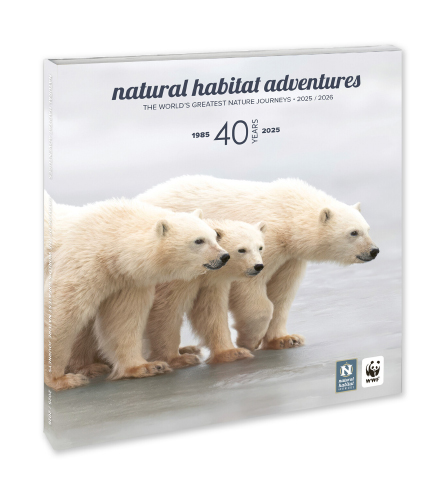Photo © World Wildlife Fund
The Galapagos Islands is one of the last remaining refuges for endangered sea turtles, nature’s ancient and intrepid mariners. Globally, there are seven species of sea turtles, nearly all of which are endangered and five of which are supported by World Wildlife Fund conservation efforts , including green, hawksbill, loggerhead, leatherback and olive ridley species.
Sea turtles face seemingly insurmountable obstacles to their survival. “Slaughtered for their eggs, meat, skin and shells, sea turtles suffer from poaching and over-exploitation. They also face habitat destruction and accidental capture in fishing gear. Climate change has an impact on turtle nesting sites. It alters sand temperatures, which then affects the sex of hatchlings.”
However, worldwide conservation efforts, including experiential education and conservation travel , remain the sea turtles’ best hope for future survival. In recent years, World Wildlife Fund scientists have even attached a camera to a sea turtle’s back in order to give researchers – and all of us – a glimpse of the world from a sea turtle’s point of view .
VIDEO
If you like seeing the world from that vantage point, then journey to the reefs off the coast of Belize , a remote destination that offers an exotic experience where you may be able to swim with sea turtles.
Visit the World Wildlife Fund website to learn more about the gentle sea turtle, global efforts to protect it, and what you can do to help.
Request Your 2025/2026 Catalog
Discover the World's Best
Nature Travel Experiences
Together, Natural Habitat Adventures and World Wildlife Fund have teamed up to arrange nearly 100 nature travel experiences around the planet, while helping to protect the magnificent places we visit and their wild inhabitants.
Discover the World's Best
Nature Travel Experiences
Our weekly eNewsletter highlights new adventures, exclusive offers, webinars, nature news, travel ideas, photography tips and more. Sign up today!
Hidden form View
Home Trips Trips Catalog Catalog
Book
Contact Contact More More Have a question or comment? Hours Mountain Time
×
Home
Trips
Trips
Catalog
Catalog
Book
Contact
Contact
More
More
[ebook-modal-wrapper]
[ebook-modal-wrapper]
[full-width-start]
[full-width-start]
[full-width-end]
[full-width-end]
[aside-height-start]
[aside-height-start]
[aside-height-end form-start]
[aside-height-end form-start]
[aside-content-start aside-text-start]
[aside-content-start aside-text-start]
[aside-text-end]
[aside-text-end]
[aside-image-start]
[aside-image-start]
[aside-image-end aside-content-end]
[aside-image-end aside-content-end]
[content-start subheader-start]
[content-start subheader-start]
[subheader-end main-header-start]
[subheader-end main-header-start]
[main-header-end image-height-start]
[main-header-end image-height-start]
[image-height-end content-end]
[image-height-end content-end]
[ebook-header-optin]
[ebook-header-optin]
[ebook-subheader-optin]
[ebook-subheader-optin]
[ebook-aside-image]
[ebook-aside-image]
[ebook-aside-text]
[ebook-aside-text]
[ebook-logos]
[ebook-logos]
[form-header-start]
[form-header-start]
[form-header-end form-start]
[form-header-end form-start]
[ebook-header-form]
[ebook-header-form]
[privacy-policy]
[privacy-policy]
[ebook-form-sms-text-wrapper]
[ebook-form-sms-text-wrapper]
[ebook-sms-privacy-wrapper]
[ebook-sms-privacy-wrapper]
[ebook-sms-fine-print]
[ebook-sms-fine-print]
[ebook-submit-button]
[ebook-submit-button]
[ebook-header-success]
[ebook-header-success]
[ebook-success-text]
[ebook-success-text]
[thank-you-start]
[thank-you-start]
[thank-you-end link-text-start]
[thank-you-end link-text-start]
[link-text-end]
[link-text-end]
[aside-start]
[aside-start]
[aside-end form-start]
[aside-end form-start]
[content-start]
[content-start]
[content-end]
[content-end]
[aside-content-start aside-image-start]
[aside-content-start aside-image-start]
[aside-image-end]
[aside-image-end]
[aside-text-start logos-start]
[aside-text-start logos-start]
[aside-text-end logos-end aside-content-end]
[aside-text-end logos-end aside-content-end]
[subheader-start]
[subheader-start]
[main-header-end aside-image-start aside-text-start]
[main-header-end aside-image-start aside-text-start]
[aside-text-end logos-start]
[aside-text-end logos-start]
[aside-image-end logos-end]
[aside-image-end logos-end]
[ebook-modal-wrapper]
[ebook-modal-wrapper]
[full-width-start]
[full-width-start]
[full-width-end]
[full-width-end]
[aside-height-start]
[aside-height-start]
[aside-height-end form-start]
[aside-height-end form-start]
[aside-content-start aside-text-start]
[aside-content-start aside-text-start]
[aside-text-end]
[aside-text-end]
[aside-image-start]
[aside-image-start]
[aside-image-end aside-content-end]
[aside-image-end aside-content-end]
[content-start subheader-start]
[content-start subheader-start]
[subheader-end main-header-start]
[subheader-end main-header-start]
[main-header-end image-height-start]
[main-header-end image-height-start]
[image-height-end content-end]
[image-height-end content-end]
[ebook-header-optin]
[ebook-header-optin]
[ebook-subheader-optin]
[ebook-subheader-optin]
[ebook-aside-image]
[ebook-aside-image]
[ebook-aside-text]
[ebook-aside-text]
[ebook-logos]
[ebook-logos]
[form-header-start]
[form-header-start]
[form-header-end form-start]
[form-header-end form-start]
[ebook-header-form]
[ebook-header-form]
[privacy-policy]
[privacy-policy]
[ebook-form-sms-text-wrapper]
[ebook-form-sms-text-wrapper]
[ebook-sms-privacy-wrapper]
[ebook-sms-privacy-wrapper]
[ebook-sms-fine-print]
[ebook-sms-fine-print]
[ebook-submit-button]
[ebook-submit-button]
[ebook-header-success]
[ebook-header-success]
[ebook-success-text]
[ebook-success-text]
[thank-you-start]
[thank-you-start]
[thank-you-end link-text-start]
[thank-you-end link-text-start]
[link-text-end]
[link-text-end]
[aside-start]
[aside-start]
[aside-end form-start]
[aside-end form-start]
[content-start]
[content-start]
[content-end]
[content-end]
[aside-content-start aside-image-start]
[aside-content-start aside-image-start]
[aside-image-end]
[aside-image-end]
[aside-text-start logos-start]
[aside-text-start logos-start]
[aside-text-end logos-end aside-content-end]
[aside-text-end logos-end aside-content-end]
[subheader-start]
[subheader-start]
[main-header-end aside-image-start aside-text-start]
[main-header-end aside-image-start aside-text-start]
[aside-text-end logos-start]
[aside-text-end logos-start]
[aside-image-end logos-end]
[aside-image-end logos-end]
[ebook-modal-wrapper]
[ebook-modal-wrapper]
[ebook-background-image]
[ebook-background-image]
[ebook-header-optin]
[ebook-header-optin]
[ebook-subheader-optin]
[ebook-subheader-optin]
[privacy-policy]
[privacy-policy]
[ebook-form-sms-text-wrapper]
[ebook-form-sms-text-wrapper]
[ebook-sms-privacy-wrapper]
[ebook-sms-privacy-wrapper]
[ebook-sms-fine-print]
[ebook-sms-fine-print]
[ebook-submit-button]
[ebook-submit-button]
[ebook-header-success]
[ebook-header-success]
[ebook-success-text]
[ebook-success-text]
[full-width-start]
[full-width-start]
[full-width-end]
[full-width-end]
[image-height-start]
[image-height-start]
[image-height-end content-start]
[image-height-end content-start]
[content-end]
[content-end]
[content-start subheader-start]
[content-start subheader-start]
[subheader-end main-header-start]
[subheader-end main-header-start]
[main-header-end form-start]
[main-header-end form-start]
[form-end content-end]
[form-end content-end]
[full-width-start logos-start]
[full-width-start logos-start]
[image-height-start logos-start]
[image-height-start logos-start]
[logos-start]
[logos-start]
[logos-end content-start]
[logos-end content-start]
[full-height-start]
[full-height-start]
[logos-start content-start]
[logos-start content-start]
[logos-end content-end full-height-end]
[logos-end content-end full-height-end]
[main-header-start]
[main-header-start]
[main-header-end subheader-start]
[main-header-end subheader-start]
[subheader-end form-start]
[subheader-end form-start]
[thank-you-start]
[thank-you-start]
[thank-you-end link-text-start]
[thank-you-end link-text-start]
[link-text-end]
[link-text-end]
[ebook-modal-wrapper]
[ebook-modal-wrapper]
[ebook-background-image]
[ebook-background-image]
[ebook-header-optin]
[ebook-header-optin]
[ebook-subheader-optin]
[ebook-subheader-optin]
[privacy-policy]
[privacy-policy]
[ebook-form-sms-text-wrapper]
[ebook-form-sms-text-wrapper]
[ebook-sms-privacy-wrapper]
[ebook-sms-privacy-wrapper]
[ebook-sms-fine-print]
[ebook-sms-fine-print]
[ebook-submit-button]
[ebook-submit-button]
[ebook-header-success]
[ebook-header-success]
[ebook-success-text]
[ebook-success-text]
[full-width-start]
[full-width-start]
[full-width-end]
[full-width-end]
[image-height-start]
[image-height-start]
[image-height-end content-start]
[image-height-end content-start]
[content-end]
[content-end]
[content-start subheader-start]
[content-start subheader-start]
[subheader-end main-header-start]
[subheader-end main-header-start]
[main-header-end form-start]
[main-header-end form-start]
[form-end content-end]
[form-end content-end]
[full-width-start logos-start]
[full-width-start logos-start]
[image-height-start logos-start]
[image-height-start logos-start]
[logos-start]
[logos-start]
[logos-end content-start]
[logos-end content-start]
[full-height-start]
[full-height-start]
[logos-start content-start]
[logos-start content-start]
[logos-end content-end full-height-end]
[logos-end content-end full-height-end]
[main-header-start]
[main-header-start]
[main-header-end subheader-start]
[main-header-end subheader-start]
[subheader-end form-start]
[subheader-end form-start]
[thank-you-start]
[thank-you-start]
[thank-you-end link-text-start]
[thank-you-end link-text-start]
[link-text-end]
[link-text-end]
[ebook-modal-wrapper]
[ebook-modal-wrapper]
[ebook-background-image]
[ebook-background-image]
[ebook-header-optin]
[ebook-header-optin]
[ebook-subheader-optin]
[ebook-subheader-optin]
[privacy-policy]
[privacy-policy]
[ebook-form-sms-text-wrapper]
[ebook-form-sms-text-wrapper]
[ebook-sms-privacy-wrapper]
[ebook-sms-privacy-wrapper]
[ebook-sms-fine-print]
[ebook-sms-fine-print]
[ebook-submit-button]
[ebook-submit-button]
[content-start main-header-start]
[content-start main-header-start]
[main-header-end subheader-start]
[main-header-end subheader-start]
[subheader-end content-end]
[subheader-end content-end]
[ebook-header-success]
[ebook-header-success]
[ebook-success-text]
[ebook-success-text]
[full-width-start]
[full-width-start]
[full-width-end]
[full-width-end]
[image-height-start]
[image-height-start]
[image-height-end content-start]
[image-height-end content-start]
[content-end]
[content-end]
[content-start subheader-start]
[content-start subheader-start]
[subheader-end main-header-start]
[subheader-end main-header-start]
[main-header-end form-start]
[main-header-end form-start]
[form-end content-end]
[form-end content-end]
[full-width-start logos-start]
[full-width-start logos-start]
[image-height-start logos-start]
[image-height-start logos-start]
[logos-start]
[logos-start]
[logos-end content-start]
[logos-end content-start]
[full-height-start]
[full-height-start]
[logos-start content-start]
[logos-start content-start]
[logos-end content-end full-height-end]
[logos-end content-end full-height-end]
[main-header-start]
[main-header-start]
[subheader-end form-start]
[subheader-end form-start]
[thank-you-start]
[thank-you-start]
[thank-you-end link-text-start]
[thank-you-end link-text-start]
[link-text-end]
[link-text-end]
[ebook-modal-wrapper]
[ebook-modal-wrapper]
[ebook-background-image]
[ebook-background-image]
[ebook-header-optin]
[ebook-header-optin]
[ebook-subheader-optin]
[ebook-subheader-optin]
[privacy-policy]
[privacy-policy]
[ebook-form-sms-text-wrapper]
[ebook-form-sms-text-wrapper]
[ebook-sms-privacy-wrapper]
[ebook-sms-privacy-wrapper]
[ebook-sms-fine-print]
[ebook-sms-fine-print]
[ebook-submit-button]
[ebook-submit-button]
[ebook-header-success]
[ebook-header-success]
[ebook-success-text]
[ebook-success-text]
[full-width-start]
[full-width-start]
[full-width-end]
[full-width-end]
[image-height-start]
[image-height-start]
[image-height-end content-start]
[image-height-end content-start]
[content-end]
[content-end]
[content-start subheader-start]
[content-start subheader-start]
[subheader-end main-header-start]
[subheader-end main-header-start]
[main-header-end form-start]
[main-header-end form-start]
[form-end content-end]
[form-end content-end]
[full-width-start logos-start]
[full-width-start logos-start]
[image-height-start logos-start]
[image-height-start logos-start]
[logos-start]
[logos-start]
[logos-end content-start]
[logos-end content-start]
[full-height-start]
[full-height-start]
[logos-start content-start]
[logos-start content-start]
[logos-end content-end full-height-end]
[logos-end content-end full-height-end]
[main-header-start]
[main-header-start]
[main-header-end subheader-start]
[main-header-end subheader-start]
[subheader-end form-start]
[subheader-end form-start]
[thank-you-start]
[thank-you-start]
[thank-you-end link-text-start]
[thank-you-end link-text-start]
[link-text-end]
[link-text-end]





























